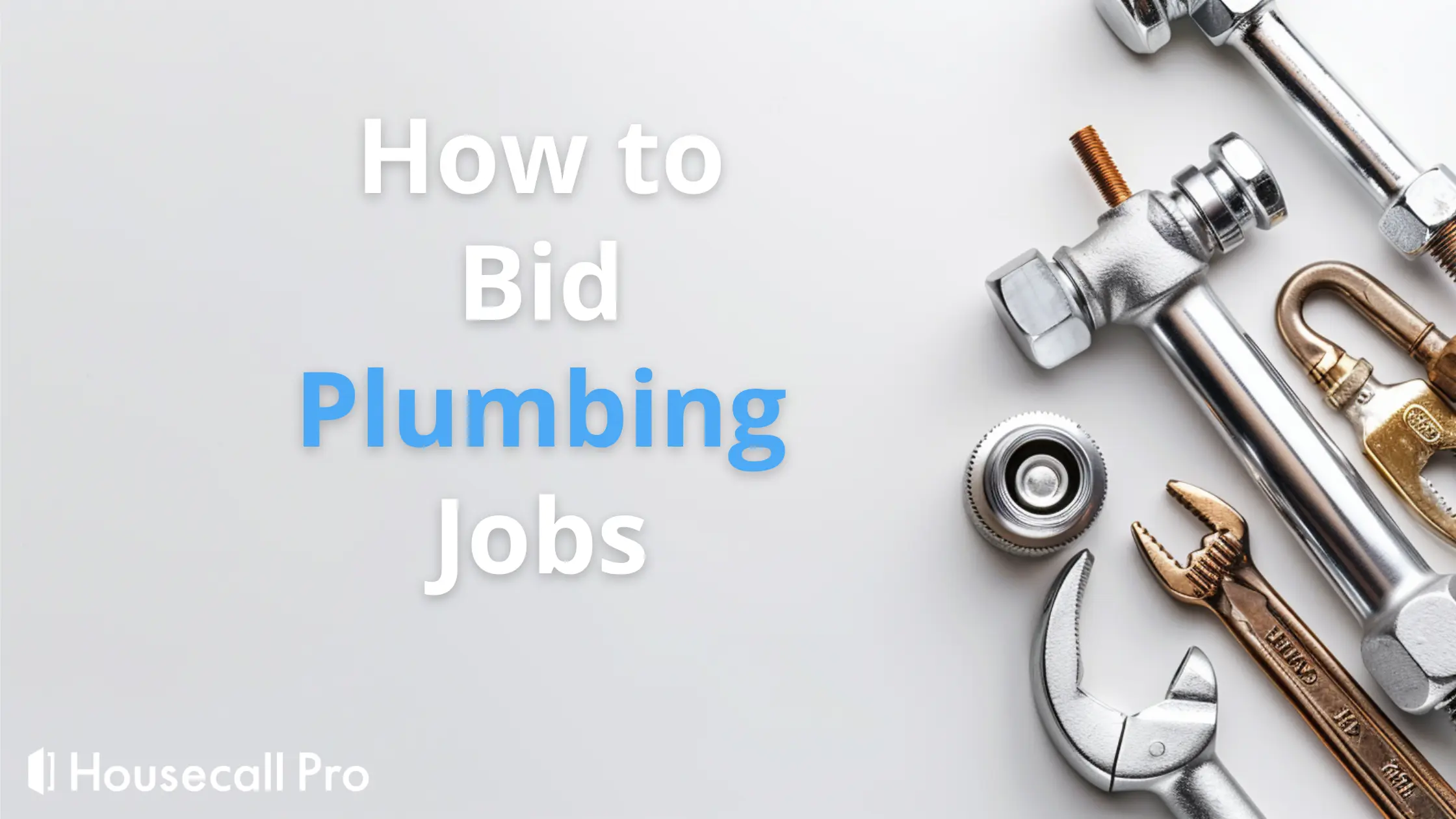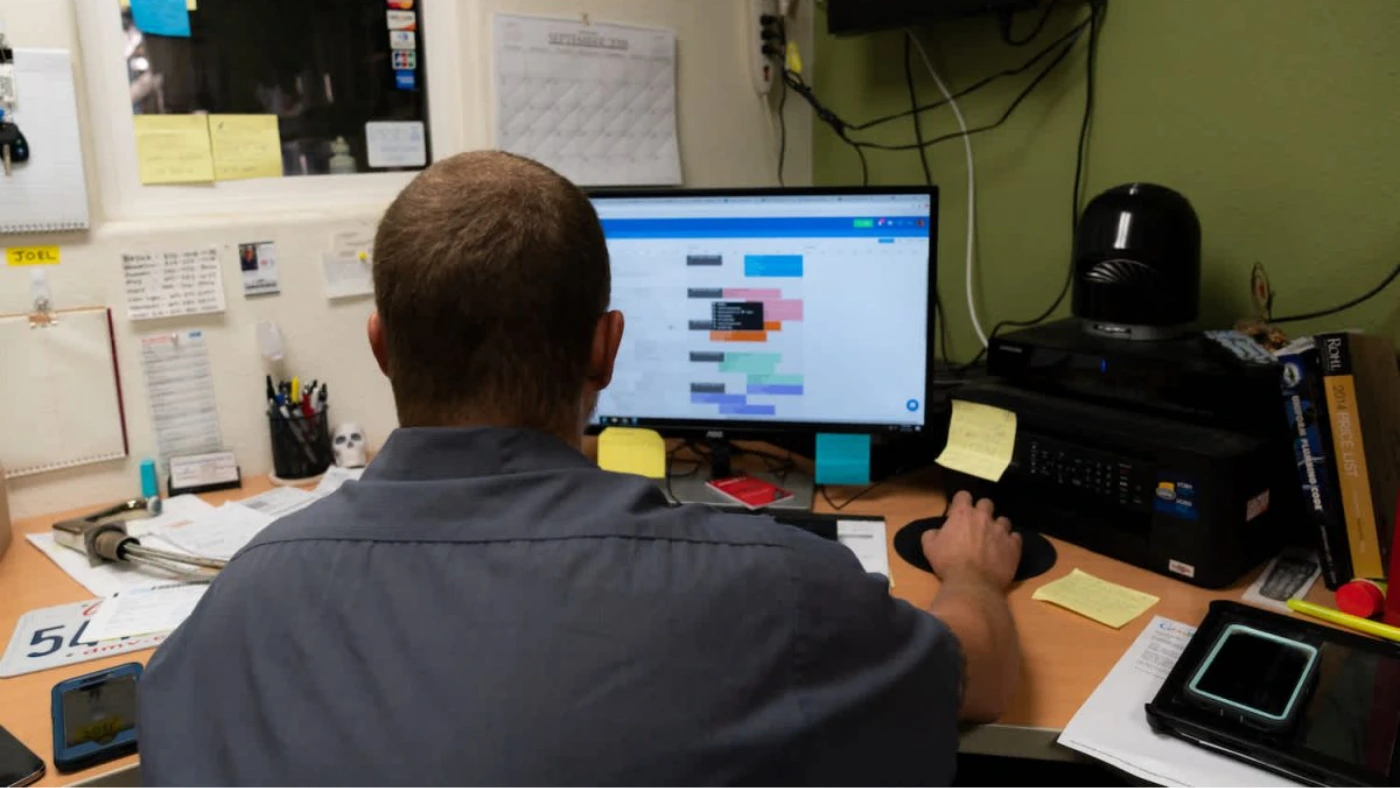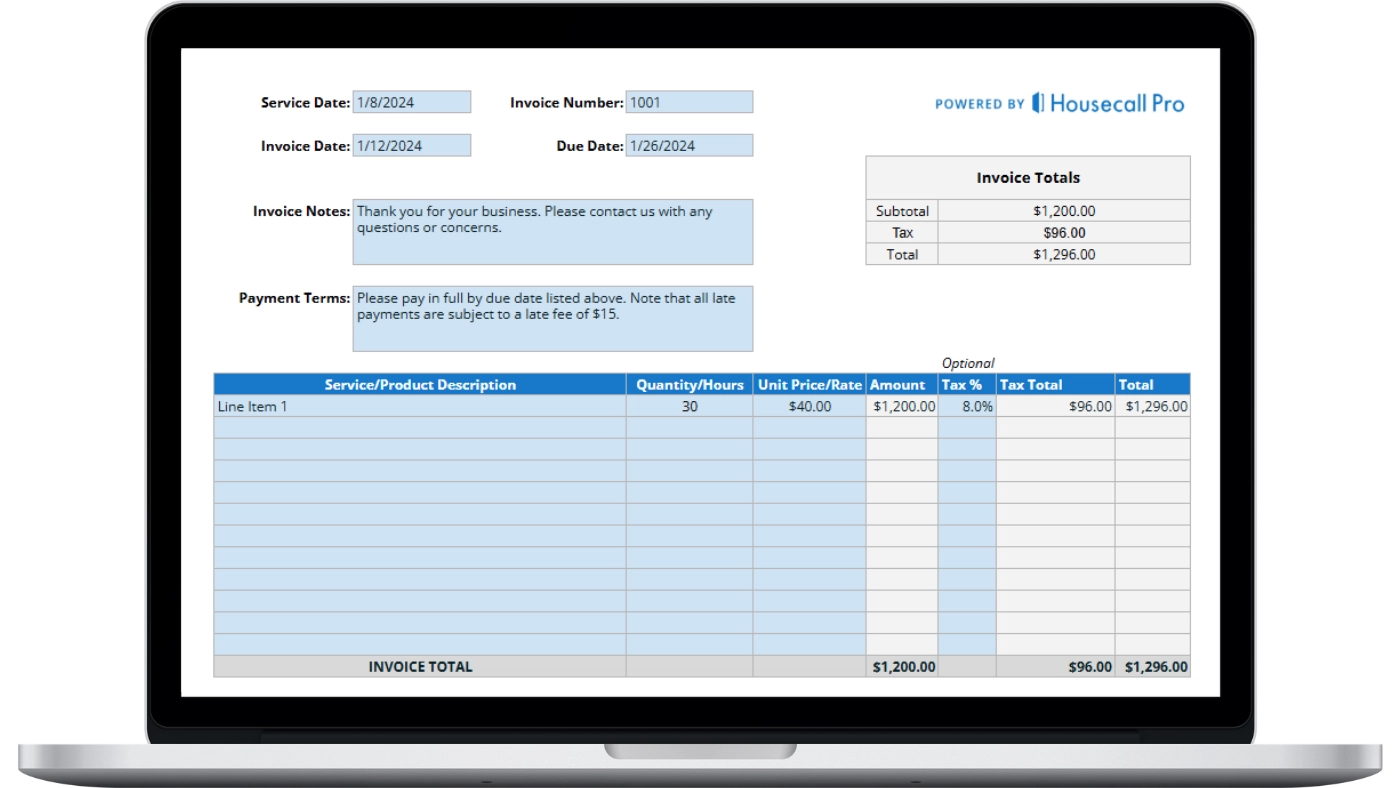
Running a plumbing business is only as good as the business you bring to the table. If you are just starting, generating an audience or new leads takes work. Bidding on jobs is vital to your success. You can use Housecall Pro’s 100% Free Plumbing Bid Template, but you need to know how to create a bid in the first place and how to find the right ones to bid on.
How do you get out there and grab potential opportunities to grow your plumbing business? This article walks you through how to bid on plumbing jobs. You start with identifying the types of jobs you can bid on, choosing the right ones, creating your material takeoff, determining labor, and creating an acceptable, competitive bid. With that in mind, let’s get started!
Understanding the Different Types of Plumbing Bids
Before building an estimate and bidding, you must know what plumbing job types are available. You also want to decide which types of projects you want to work with. There are three main plumbing project categories, including residential, commercial, and government plumbing projects. Let’s break it down.
Residential Plumbing Projects
Residential plumbing jobs are in high demand, but the competition is fierce. In addition, you are dealing with homeowners and property owners who are almost always looking for a decent price point. Therefore, work is in high demand, but you make less per job. You also need to consider what competitors offer so you can provide an estimate that sells itself and wins the customer.
Residential plumbing jobs often include drain clogs, running toilets, sewer backflow, new line installations, gas line inspections, water heaters, and even vanity installs.
Commercial Plumbing Jobs
Commercial plumbing services are different from residential jobs. There is less demand for commercial plumbing services than for residential needs (still often at high levels), but you get higher job estimates and payment success. The challenge is to create bids that cover materials, equipment, labor, overhead, subcontracting (if applicable), and profit.
Commercial jobs often include restaurants, medical facilities, new construction projects, retail stores, apartments, etc.
Government Plumbing Work
Government plumbing jobs are in a league of their own. Bidding requires a lot more detail, patience, and time. It requires more paperwork, job details, pricing details, and specific instructions for submitting bids.
Government jobs often include federal, state, and local municipal plumbing services. These jobs include irrigation systems, new construction, ceiling leaks, vent piping replacements, building additions, facility upgrades, renovations, well installations, sewage system installations, and general plumbing tasks for buildings and parks.
How To Bid a Plumbing Job to Secure More Work
Bidding on plumbing jobs, whether residential, commercial, or governmental, requires some degree of experience to calculate costs correctly and bid safely. A simple mistake can lead to losses rather than profit, not to mention dissatisfied clients or customers.
You should also be able to account for potential delays, such as paperwork, licenses, permits, weather, approvals, no-shows, third-party contractors, etc. In addition, you need to know how long the individual tasks will take.
Considering the above information, here’s how to bid on a plumbing job in eight detailed steps.
1. Choose the Right Plumbing Job to Bid On
The first task is to find the right plumbing jobs based on your skills and experience. Don’t try to bid on jobs you have minimal experience with because it can be challenging to create an accurate estimate properly.
If you target residential plumbing installations and repairs, you should know the typical labor charges for the area and how long each task will take. Experience is critical to closer estimations.
For commercial plumbing jobs, your bid/estimate should include estimated labor hours and charges similar to residential work but also account for third-party tasks, supervision salaries (usually a separate item), etc.
For governmental plumbing bids, you may need special permits, proof of licenses, insurance, etc. You’ll have to calculate hours based on many factors, such as whether you are performing a governmental, state, county, or local city/municipality job, and know the possible setbacks concerning labor time.
For more information on pricing your bid, you can check out our plumbing cost estimator guide for additional information to get you going.
2. Collect & Review Project Specs
Aside from residential plumbing services, where you simply provide a quote (your bid for the job), commercial and governmental work often comes with an invitation to bid (ITB) or request for proposal (RFP). The supplied documents include details on the job, including the specific tasks to perform and their installation methods, materials needed to perform the work, building information, and more.
You’ll want to thoroughly review all supplied information before you create your estimate/bid.
Most companies use the MasterFormat standardized system, a product created by Construction Specifications Institute (CSI) [US] and Construction Specifications Canada (CSC) [Canada], which is a format that provides specific details on the plumbing job, as well as all other construction job details, building specifications, etc. Everyone taking part in the project uses the same information to remain on the same page, including architects, construction companies, plumbers, electricians, and more.
Reviewing and Understanding The MasterFormat System
You’ll most likely receive documents using the MasterFormat system, which consists of Divisions (Level 1), Sections (Level 2), and Subsections (Level 3). The information you need regarding plumbing job bid offers will likely reside in Division 1 and Division 22, but you’ll also have to reference other Divisions. This set of documents provides detailed information on product specifications and requirements so you can effectively determine what products you’ll need and how much they’ll cost you.
To better understand The MasterFormat system, it is a standardized format designed to keep everyone on the same page, whether in construction, plumbing, electrical, HVAC, design, etc. This “specifications book” is essentially designed to organize and communicate building specifications to all parties involved in the complete construction job, from designing and building to installing and establishing.
Divisions (Level 1) are “material categories” for specific parts of construction, such as “concrete,” “metal,” “electrical,” “plumbing,” etc.
Sections (Level 2) break down each division, providing specifics within each one. So, Plumbing (Division 22) breaks down into Plumbing Piping (Section 10), Plumbing Insulation (Section 7), Plumbing Equipment (Section 30), Plumbing Fixtures (Section 40), etc.
Subsections (Level 3) further break down the Sections (Level 2), so the Concrete (Division 22) and its Plumbing Insulation (Section 7) divides into subsections, including Plumbing Equipment Insulation (Subsection 16) and Plumbing Equipment Piping (Subsection 19).
All three levels in the MasterFormat system appear as three groups of digits, such as 22 7 19, where 22 is “Plumbing,” 7 is “Plumbing Insulation,” and 19 is Plumbing Equipment Piping. If a fourth level is needed, it will appear after level 3, followed by a period/decimal.
The primary purpose of using MasterFormat is to maintain uniformity among contractors and construction specialists and ensure everything meets codes and regulations. For detailed information, refer to the CSI MasterFormat Division, Section, and Subdivision numbers website.
3. Conduct Plumbing Material Takeoff
Now that you have determined all the materials needed for the job, it’s time to create your plumbing materials quantity takeoff. You need to make a list of the quantities required. It’s generally best to separate materials based on each particular task.
What to Include in Your Plumbing Quantity Takeoff
This step is where you calculate all items and materials/supplies. Items include various pipes and their needed lengths, fittings, elbows, flanges, insulation, water tanks, sinks, faucets, gaskets, drain covers, etc. Materials include plumbing tape, thread seal, protective gloves, pipe-cutting blades, etc.
To simplify the list, use labels, codes, etc., from the documents you received from the client, such as labeling an item as “Men’s B2,” “Fitting C3,” etc.
When you detail your plumbing bid, you want the potential client to understand the charges and what they are for. Housecall Pro’s 100% FREE plumbing proposal template can simplify and streamline the estimating process.
Get In Touch: 858-842-5746
Let us earn your trust
On average, Pros increase monthly revenue generated through Housecall Pro by 50% after their first year.
See plan options and feature breakdown on our pricing page.
4. Get Quotes from Suppliers
Now, you have your quantity takeoff showing how many of each item you need for the job. Get quotes from various providers based on the quantities you need for each item. In some cases, an extra one or two can be cheaper than without counting them due to bulk price points. Once you have the material and item costs, add them to your estimate.
5. Calculate Labor Costs
With products on your estimate, it is now time to add labor. This section can be tricky, especially for inexperienced job scenarios. There are three types of labor to include.
- Labor unit: A labor unit involves calculating hourly labor, estimated at around 60-70% for installation work and 30-40% for material handling and cleanup.
- Burdened labor costs: Burdened labor costs are the expenses per labor unit, including all non-wage costs per hour, excluding supervisory salaried jobs.
- Supervision costs: Supervision employees usually have salaries rather than wages, so you exclude them from your hourly labor costs. However, you may not need supervisory positions. It depends on the projects you work on. You’ll calculate the hourly salary and include that in your burdened labor costs for the specified timeframe.
6. Add Overhead & Preferred Profit Margin
Overhead includes indirect costs needed to operate the business but excludes labor, materials, and job products. Understanding overhead when adding it to your estimate/bid is key.
Overhead includes:
- Property lease(s)
- Property taxes
- Third-party services (for your plumbing business, not the potential job), which include training, bookkeeping, janitorial service within your building(s), etc.
- Utility costs, such as electric, gas, internet, phone, sanitation service, etc.
- Marketing, such as social advertising, website hosting, newspaper ads, etc.
- Licenses, permits, certifications, etc., such as state/federal/local permits and training certifications
- Insurance costs for property, vehicles, employees, etc.
- Business software for managing your plumbing business
- And, much more
The three types of overhead to include and calculate in your estimate/bid:
Fixed Overhead: The fixed type consists of expenses that remain constant every month, such as property taxes, licenses, rent, salaries, etc.
Variable Overhead: Variable expenses include costs that change daily, weekly, monthly, or annually, such as marketing and advertising costs, office supplies, fuel, legal service costs, and shipping.
Semi-Variable Overhead: Semi-variable expenses include not only fixed costs but also variable costs, such as electric service, gas provider service, employee bonuses, audit fees, commissions, etc.
You calculate the three overhead categories above based on the estimated job period. Then, you add them to your estimate and bid amount. When referencing the job’s estimated duration, overhead is often percentage-based.
7. Create Your Proposal
Now that you have successfully calculated your material and item costs, labor, and overhead, you can use plumbing proposal software to build your bid.
8. Review & Submit Your Bid
With all the information and details in place, you can place your bid, following the instructions from the potential client. Government jobs often require you to register on a website where you’ll provide all the necessary information, such as your licenses, permits, insurance, address, phone, email, bid amount, estimate details, etc. Some commercial jobs also require online registration, but it only happens sometimes.
Tips for Creating Winning Plumbing Bids
Creating plumbing bids is complicated, primarily because you compete with other plumbing companies and generally require much information in your estimate. Regardless of what type of plumbing job you bid on (residential, commercial, governmental), there are several things you can do to help create a winning bid.
1. Choose the Right Jobs
You should never jump on a bidding train just to get more opportunities and increase your chance of winning a job. Stick with jobs you have extensive experience with, such as those where you understand the ins and outs of doing them. Producing reliable estimates requires knowledge generated from experience.
2. Use the Right Software
Using software to create your estimates/bids is essential to ensure accuracy and legibility for all involved. You can use predesigned forms to fill in the details of your estimate. Still, it is always better to utilize complete plumbing business software that ensures all necessary information is included in the estimate and interacts with other parts of the software.
How to Find Plumbing Jobs to Bid On
Finding plumbing jobs to bid on is tedious, but there are more ways to connect to opportunities than just researching the internet. Many other methods produce better opportunities than what you find searching the web. Here are some excellent recommendations to help you find plumbing jobs to bid on.
1. Network with Other Local Businesses
Connecting with other businesses often leads to referrals and information. You can join your county’s or municipality’s Chamber of Commerce. You can also partner with local companies to increase your chances of success! For instance, connecting with local construction companies is to your advantage.
2. Monitor Government Bid Boards and Contractor Portals
If you’re after governmental plumbing jobs, browse online bid boards and contractor portals. You’ll find many biddable plumbing jobs based on location and other factors, such as the type of plumbing work.
Some good sources for government bidding jobs include:
- GOVCB (Government Contracts and Bids), where you can find biddable plumbing jobs based on state, city, or municipality.
- HIGHERGOV, where you can find plumbing jobs based on “federal” or “state and local” filters in addition to job types based on various filters, including “classes” such as North American Industry Classification System (NAICS) Codes and Product and Service Codes (PSCs).
3. Attend Industry Events and Conferences
You can attend plumbing-related events and conferences to connect with others in the same industry. However, it does not have to be a plumbing-specific event. In fact, construction and contractor events and conferences provide new connections and information, leading to more bidding opportunities.
4. Advertise Your Plumbing Services
One essential business rule is to advertise, no matter your industry. You need your name out there to become recognizable, reputable, and available to those needing plumbing services. Word-of-mouth recommendations can only spread if you advertise and let everyone know about your business.
Recommended ways to advertise your plumbing services to obtain more bids include:
- Social media marketing (ads, Facebook page, etc.)
- Google Ads and other similar ad programs to generate attention and traffic
- Billboards
- Sponsorships
- Your very own website
Utilizing the various advertising channels above helps make your name and services known, which can lead to more recommendations. Attending events, joining local businesses, and advertising work together to form a powerhouse of opportunity to get more bid offers.
Free Plumbing Bid & Proposal Template
Another great resource is plumbing bid and proposal templates, which produce clear, detailed information in a readable, understandable format. Being clear and concise is essential to bidding on plumbing jobs, and templates provide clean layouts to make your proposal understandable and attractive. Housecall Pro’s free plumbing proposal template can deliver the clarity, preciseness, and detail you need.
Streamline Your Bidding Process With Plumbing Business Software
Plumbing software is the way to go if you want to save time while also delivering detailed estimates, proposals, and bids. The advantage is in integration. Everything works together to produce associated data in various applications and save time so you can focus on profit.
Housecall Pro’s Plumbing Business Software Allows You To:
- Create plumbing estimates
- Get detailed proposals
- Good, better, and best options to choose from
- Create recurring service plans for repeat business
- Manage online reviews
- Follow-up reminders on past-due estimates
- Streamlined labor rates and pricelists, as well as other needed business data
- Professionally branded, customized templates
- And, more!
Check out Housecall Pro’s Plumbing Business Software and sign up for a 14-day free trial today.






